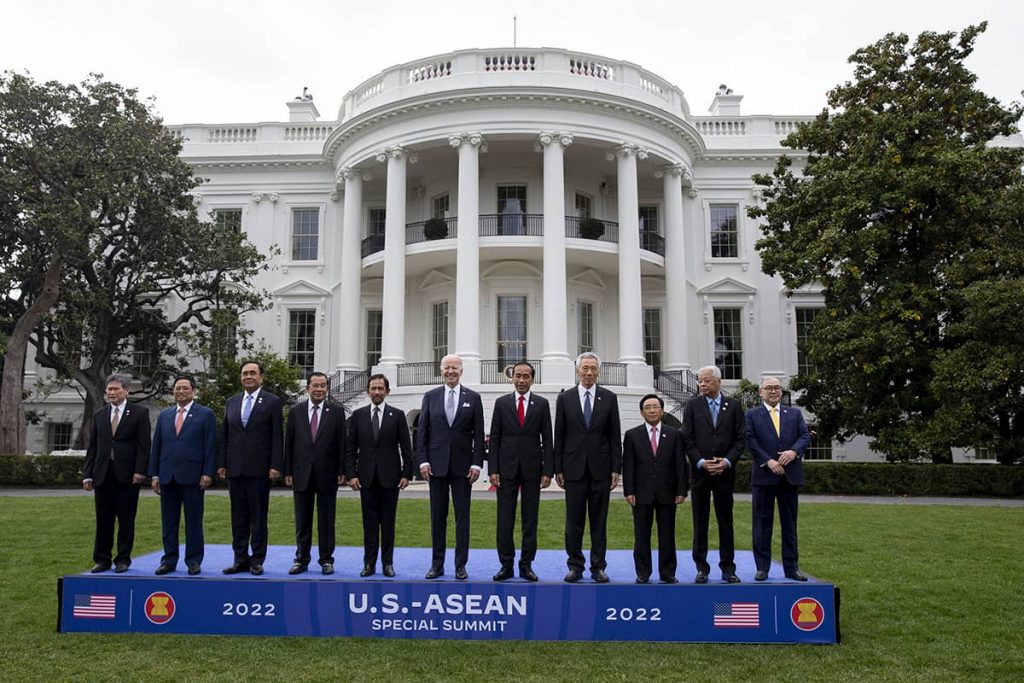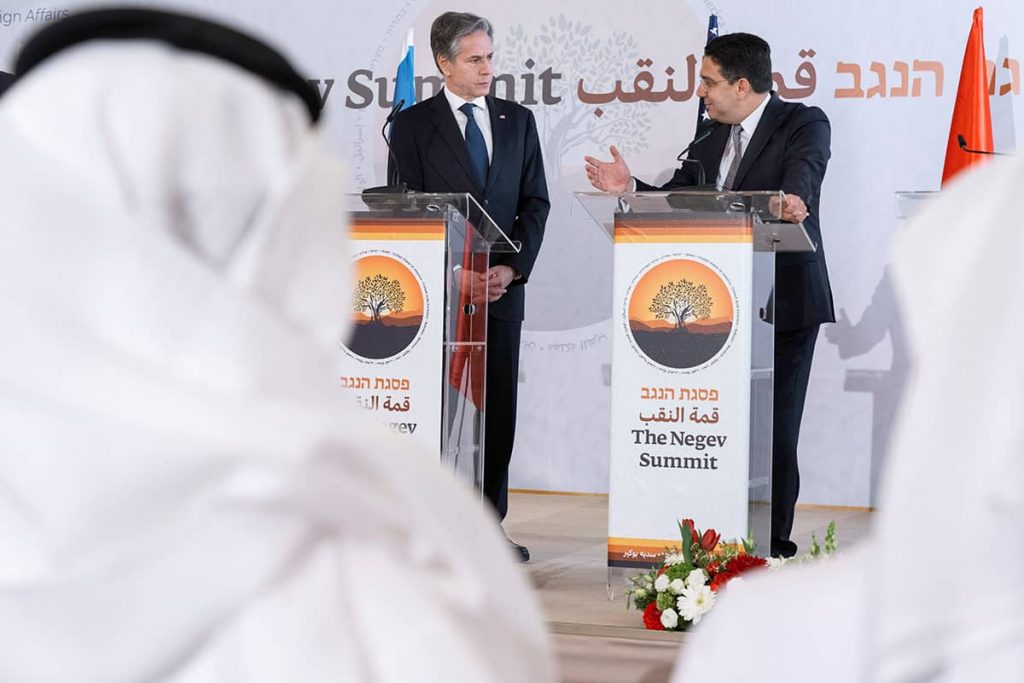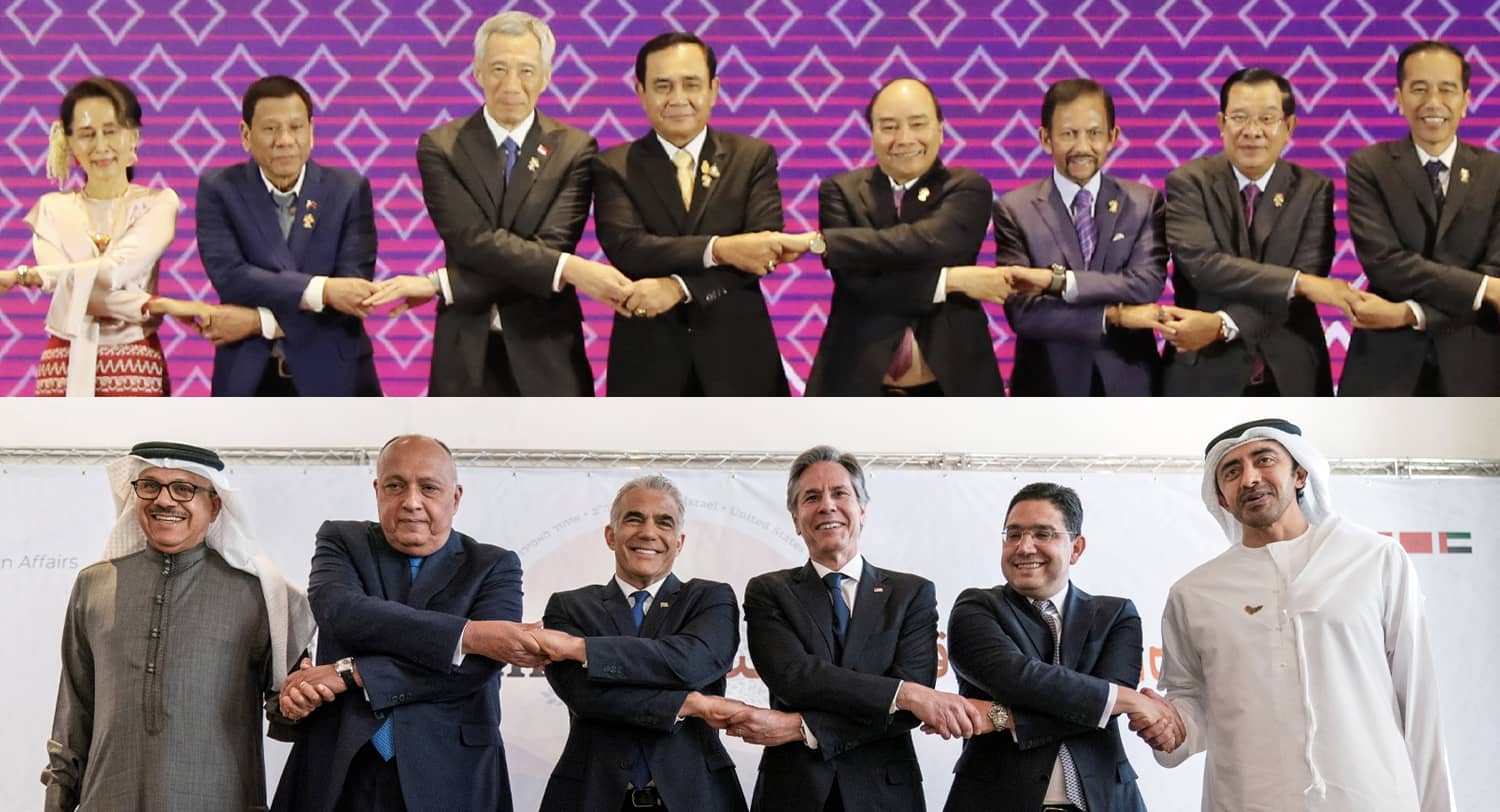The summit of foreign ministers came together on relatively short notice. It was unstructured, informal, with little of the staff work or pre-negotiation that normally precedes such gatherings. The agenda was slim and general, and the outcome rather modest. But viewed through a historical scope, the results were transformational.
I am not referring to the Negev Summit held in March 2022. On that occasion, Yair Lapid, Israel’s foreign minister took advantage of an upcoming visit of US Secretary of State Antony Blinken to fire off WhatsApp messages inviting his regional counterparts to join them. The foreign ministers of the United Arab Emirates, Bahrain, Morocco, and Egypt flew to Israel, and, in an unprecedented fashion, all sat at one table with their Israeli host and his American guest.
The Negev Summit produced more than photo-ops. The ministers announced the establishment of six working groups on security, energy, health, education, water and food security, and tourism. In a follow-up meeting in Bahrain in June, the Negev Forum was established; working group co-chairs are being appointed. The process is buttressed by non-governmental efforts, like the N7 Initiative that I am involved with through the Atlantic Council. Another meeting of the foreign ministers, and possibly even a heads of state summit, is planned, although the upcoming Israeli election will probably delay it into early 2023.
In addition to doing the daily work of building and deepening these relationships, advocates of integration should be thinking long-term—not just months ahead, but years, even decades into the future. And as we do, we should open up our imaginations as to what the Middle East could look like.
For that, it helps to have models to emulate. There is no one model to turn to, but perhaps the gold standard of what regional integration in the Middle East could look like is from a region thousands of miles to the east—Southeast Asia.
Which brings us back to that earlier summit. The year was 1967. While the Middle East was convulsed by its own conflicts, the nations of Southeast Asia, just emerging from the colonial era, had been riven by disputes. Indonesia and Malaysia had fought a low-grade border war on the island of Borneo, and Malaysia and the Philippines were also at loggerheads over conflicting territorial claims. War still raged in nearby Indochina, threatening the stability of the entire region.
At the initiative of Foreign Minister Thanat Khoman of Thailand, who had mediated the conflicts among his neighbors, he and his counterparts from Indonesia, Malaysia, the Philippines, and Singapore convened for several days in August at an isolated Thai beach resort. As ASEAN historians Jamil Maidan Flores and Jun Abad describe it the atmosphere was informal, relaxed, ideal for candid conversations and creative thinking away from the glare of cameras. The goal was to explore the creation of an organization that would enable these neighbors to strengthen their regional relationships, bring peace and prosperity to their citizens, and avoid open conflict when disagreements arose.
At the conclusion of the summit, the ministers traveled to the Thai capital and signed what became known as the Bangkok Declaration. This simple, four-page document announced the formation of the Association of Southeast Asian Nations (ASEAN). To be honest, it did little else. The remaining paragraphs included fairly boilerplate language about neighborliness, increased cooperation in various fields, the promotion of peace and stability, and a pledge to convene regular meetings of foreign ministers.
It reads like any of thousands of communiques drafted at multilateral meetings. It could have amounted to very little. But from those modest beginnings, an organization emerged that far outstrips the expectations of even its founders. It took time, but today, ASEAN represents an extraordinary exercise in regional integration. As Khoman said at the signing ceremony, ASEAN could enable “building a new society that will be responsive to the needs of our time and efficiently equipped to bring about, for the enjoyment and the material as well as spiritual advancement of our peoples, conditions of stability and progress.” Indeed, it has.
The foreign ministers of the five founding members did, indeed, begin to meet regularly. Then, starting in 1976, ASEAN heads of state began attending summits, with the frequency increasing to as much as twice a year. Intervening meetings of the foreign ministers helped prepare the heads of state summits. Today, there are regular meetings of ministers with other areas of responsibility—energy, health, trade, agriculture, and so on—with their ASEAN counterparts. The ASEAN members agreed on a rotating annual chairmanship and the creation of a secretariat whose leadership also passes among its members, which coordinates many of the gatherings and assists in implementation of regional projects.
Not surprisingly, other regional countries saw advantages in ASEAN membership, and the organization expanded. Brunei Darussalam joined in 1984, followed by Vietnam in 1995, and Laos and Myanmar in 1997. When Cambodia finally signed on in 1999, it brought ASEAN to its current total of ten members states, representing, today, a population of some 670 million citizens.
The original ASEAN has evolved and grown over the years. In 1992, the ASEAN Free Trade Agreement (AFTA) was signed, leading to the phased elimination of tariffs and customs duties on trade between the countries. In 2009, an ASEAN human rights body was established, with the stated aim of allowing the member states to hold each other accountable for upholding certain standards. ASEAN began to engage other nations and regional groups as a bloc, signing free trade agreements with Australia and New Zealand, China, India, and South Korea, hosting foreign ambassadors to its secretariat, and convening summits with foreign leaders. US Secretaries of State have even indulged in parody song performances, matching the light atmosphere their ASEAN hosts prefer. At the last US–ASEAN summit with President Biden at the White House in May, the atmosphere was a bit more formal.

The organization also spawned significant non-governmental cooperation. The private sectors of the ten countries have similarly aligned themselves, prioritizing their regional partnerships, with organizations of ASEAN engineers, lawyers, surgeons, shippers, and dozens of other professions coming to life. Civil society organizations and universities also pursue first-order partnerships with their counterparts in ASEAN countries. The intensity of people-to-people exchanges across ASEAN members is vast and perhaps immeasurable.
Strikingly, ASEAN membership has proven stable and mutually beneficial despite the diversity of its members. They are large (Indonesia) and small (Singapore); rich (Brunei) and poor (Laos); closely affiliated with the United States (Thailand, the Philippines) or much more aligned with China or Russia (Cambodia, Vietnam). Several have undergone transitions to more democratic governance, while others have backslid away from it. They span a wide range of religious, cultural, and economic characteristics.
Nevertheless, all these nations have consistently determined that participating in the cooperation that ASEAN facilitates brings benefits to their people, their economies, their environment, and their security. They perceive that the organization strengthens the ties of the group internally, while bolstering them in dealing with external actors. ASEAN—complete with a flag, evocative symbols, and an anthem—has helped foster a common regional identity, while allowing each country to preserve its own uniqueness. Time and again, the region’s leaders rededicate themselves to sticking together, to solving problems through talking, not fighting, to building something greater than the sum of their parts.
Five and a half decades after its humble beginnings, the net effect of ASEAN is an ever-thickening web of ties between governments, peoples, private sectors, and societies that makes a descent into conflict nearly inconceivable. There is too much at stake, too many relationships, too many common interests to justify anything other than sustaining and increasing the process of regional integration.
To be clear, no model is perfect. ASEAN has its critics, even internally. There is always more to do, always more to build. Many of ASEAN’s members are not democracies, or they have democratic systems that have proven unstable. Human rights violations by several of its governments are not uncommon. Myanmar, with its brutal dictatorship and broad Western sanctions against it, has proven a particular challenge; ASEAN members have condemned the military junta’s excesses but have also faced calls to go further and suspend Myanmar’s membership. Some observers argue ASEAN is slow to reach decisions, given its requirement for consensus and inclination to defer hard choices. The secretariat is weak, by design, and chronically understaffed and underfunded. There are, it has been said, too many meetings and not enough action.
But those critiques do not undercut ASEAN’s value. An organic product of the nations of Southeast Asia, it is undeniable that it has helped prevent conflict and ensure stability, which has given rise to the incredible growth and prosperity the region has experienced—a one hundred-fold increase in GDP in its first 50 years. By some estimates, ASEAN will boast the equivalent of the world’s fourth largest economy by 2030.
Those dynamic trends have obviously benefited the people of the ASEAN countries. But not just them. As one former US Ambassador to ASEAN remarked to me, “the stability, and resulting prosperity, ASEAN has facilitated in a strategically vital region have been hugely beneficial to US interests. So has its promotion of values we share, like the rule of law and freedom of navigation.” Which helps explain why the United States has been such an active partner and enthusiastic supporter over the years—often competing with other powers to do so.

How relevant is the ASEAN model to a potential organization supporting regional integration in the Middle East and North Africa? Should it have a secretariat, operate by consensus, or negotiate as a bloc with other countries? Those are questions for the member countries to decide. An organization in the Middle East and North Africa region might look different in certain respects. It should be organic to the region, representing its members’ individual and collective interests, security needs, economies, history, identities, and cultures.
Government initiatives like the Negev Forum and non-governmental ones like the N7 Initiative have much to offer to secure the benefits of normalization. There is a need and a value for near-term evidence of how normalization can positively impact the lives of the citizens of countries who engage in it. At this early stage, these efforts are precisely what is required.
Normalization is an event. It happens, and even matures, but then that phase passes. Beyond it, there are relationships to nurture, build, and deepen, a multilateral regional architecture to erect. Regional integration represents a sea change in thinking about how the nations of the MENA region will relate to one another in the decades to come: identifying common interests, rooted in their common history, and fostering a common identity while preserving what is unique about each of them (and gaining appreciation for each other’s uniqueness). It moves beyond building trust to sustaining inherently trusting relationships, beyond proving the mutual benefits of the partnership to internalizing the logic that there are deeper gains to be harvested from thinking and acting collectively than from viewing all interests through an individual lens. And as the ASEAN experience teaches us, integration need not be held back by the diversity of the MENA countries’ sizes, economies, political systems, cultures, or religions.
Even in this heady post-Abraham Accords era, the MENA region is not there yet. It takes time. But the potential and the building blocks are there: regular multilateral meetings of senior officials; the prospect of similar meetings of officials and experts with specific responsibilities in fields like energy, health, agriculture, education, and defense; a UAE–Israel free trade agreement that could be a model, or a basis, for a regional free trade agreement; emerging people-to-people, private sector, and civil society links.
As one building block is stacked on another, as more citizens benefit in their lives, as with ASEAN, the club of regional integration is one that others will want to join. Even—in the MENA-specific context—with the requirement of crossing the threshold of normalization with Israel, as six Arab countries already have.
When it will eventually be established, there is a logical name for this regional organization: the AMENA Countries, the Association of Middle East and North African Countries. AMENA means “trustworthy” or “reliable” in both Hebrew and Arabic. It is the feminine form of the word, which applies well to states, which are feminine nouns in Semitic grammar. AMENA will instantly signal, with trilingual clarity, that it represents a community of trust, reliability, common interests, and the common benefits of security and prosperity.
This model is different from another form of integration that has been discussed in the past, a Middle East NATO-type organization. Security will always be a key pillar of the partnerships of many of the regional states, as they deal with common threats. It can be relevant in an AMENA model as well. But integration and cooperation in non-security domains deepen the partnerships, get more of the societies invested in them, and allow for a broader group of members with differentiated security needs.
This vision will take time to realize. And the precise form it takes over time cannot be known at its outset. But like the founders of ASEAN, today’s Middle Eastern and North African leaders have before them a profound opportunity to build an integrated region that bears no resemblance to what has come before and can positively affect the lives of all who live within it.



